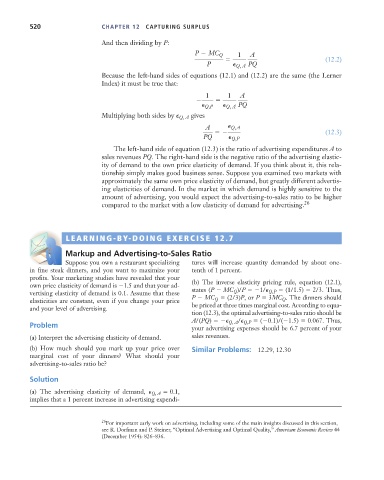Page 546 - Microeconomics, Fourth Edition
P. 546
c12capturingsurplus.qxd 7/22/10 1:10 PM Page 520
520 CHAPTER 12 CAPTURING SURPLUS
And then dividing by P:
P MC Q 1 A
(12.2)
P Q, A PQ
Because the left-hand sides of equations (12.1) and (12.2) are the same (the Lerner
Index) it must be true that:
1 1 A
Q,P Q, A PQ
Multiplying both sides by Q, A gives
A Q,A
(12.3)
PQ Q,P
The left-hand side of equation (12.3) is the ratio of advertising expenditures A to
sales revenues PQ. The right-hand side is the negative ratio of the advertising elastic-
ity of demand to the own price elasticity of demand. If you think about it, this rela-
tionship simply makes good business sense. Suppose you examined two markets with
approximately the same own price elasticity of demand, but greatly different advertis-
ing elasticities of demand. In the market in which demand is highly sensitive to the
amount of advertising, you would expect the advertising-to-sales ratio to be higher
compared to the market with a low elasticity of demand for advertising. 26
LEARNING-BY-DOING EXERCISE 12.7
S
D
E
Markup and Advertising-to-Sales Ratio
Suppose you own a restaurant specializing tures will increase quantity demanded by about one-
in fine steak dinners, and you want to maximize your tenth of 1 percent.
profits. Your marketing studies have revealed that your
own price elasticity of demand is 1.5 and that your ad- (b) The inverse elasticity pricing rule, equation (12.1),
vertising elasticity of demand is 0.1. Assume that these states (P MC Q )/P 1/ Q,P (1/1.5) 2/3. Thus,
elasticities are constant, even if you change your price P MC Q (2/3)P, or P 3MC Q . The dinners should
and your level of advertising. be priced at three times marginal cost. According to equa-
tion (12.3), the optimal advertising-to-sales ratio should be
A/(PQ) Q, A / Q,P ( 0.1)/( 1.5) 0.067. Thus,
Problem your advertising expenses should be 6.7 percent of your
(a) Interpret the advertising elasticity of demand. sales revenues.
(b) How much should you mark up your price over Similar Problems: 12.29, 12.30
marginal cost of your dinners? What should your
advertising-to-sales ratio be?
Solution
(a) The advertising elasticity of demand, Q, A 0.1,
implies that a 1 percent increase in advertising expendi-
26 For important early work on advertising, including some of the main insights discussed in this section,
see R. Dorfman and P. Steiner, “Optimal Advertising and Optimal Quality,” American Economic Review 44
(December 1954): 826–836.

